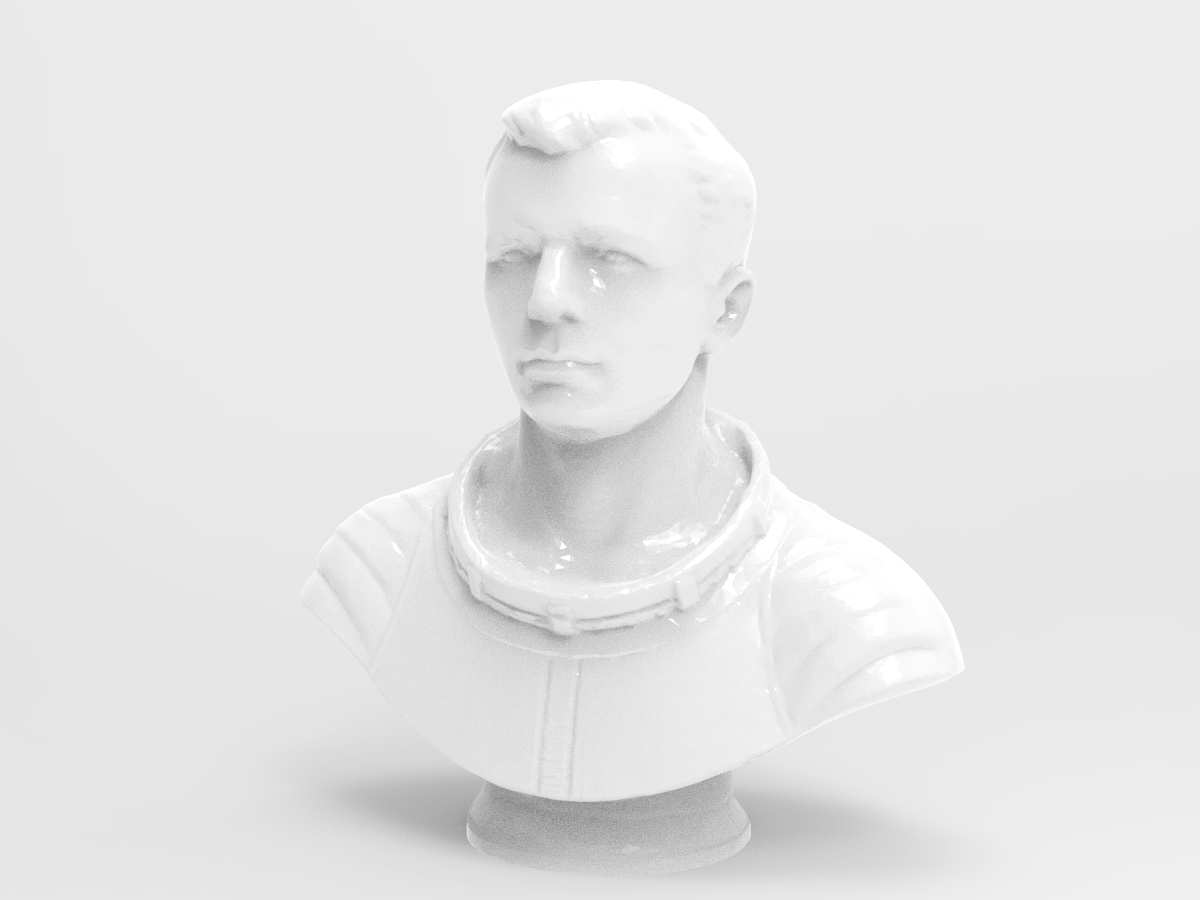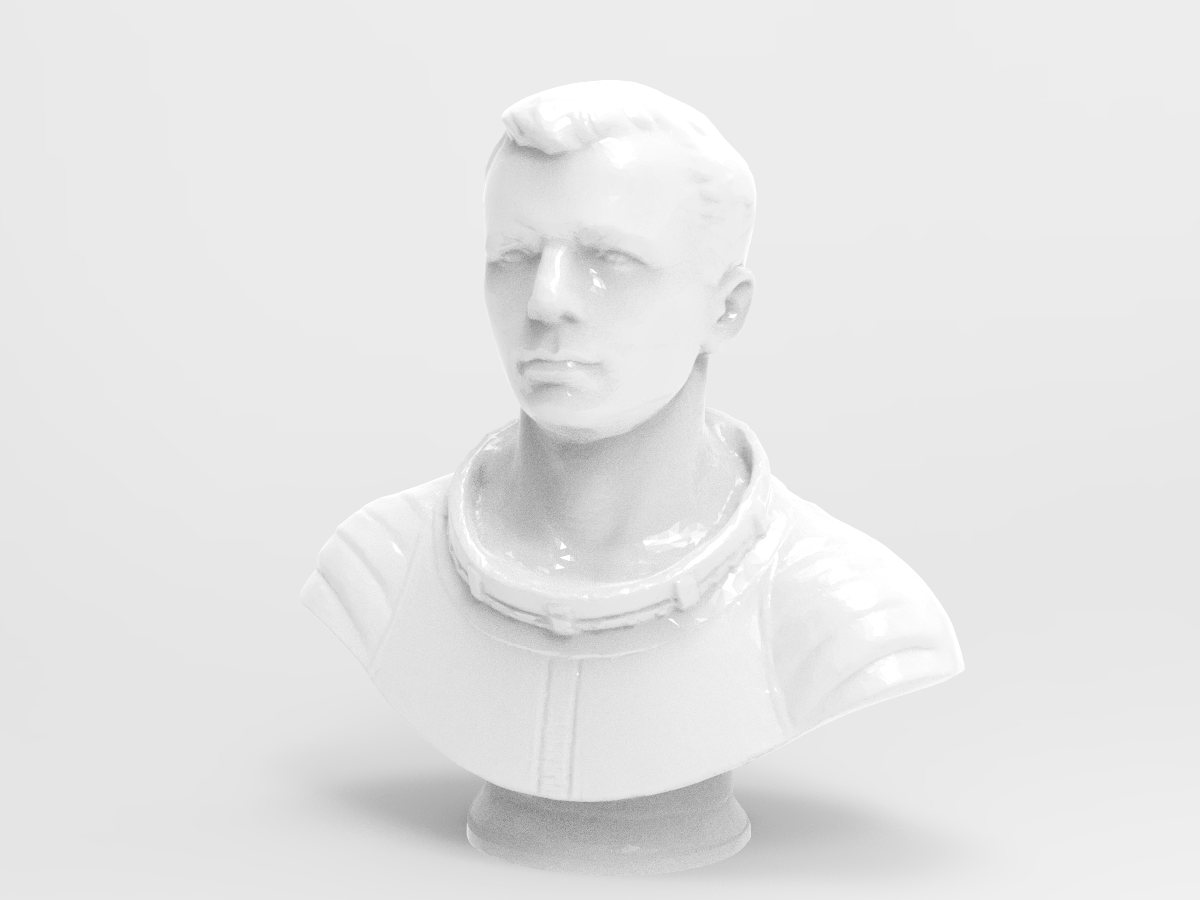8DPrintStore
YURI GAGARIN BUST
YURI GAGARIN BUST
Couldn't load pickup availability
Yuri Gagarin
Ю́рий Алексе́евич Гага́рин
Gagarin in Helsinki, 1961
Born Yuri Alekseyevich Gagarin
9 March 1934
Klushino, Smolensk Oblast, Russian SFSR, Soviet Union
Died 27 March 1968 (aged 34)
Novosyolovo, Russian SFSR, Soviet Union
Resting place Kremlin Wall Necropolis
Nationality Russian
Citizenship Soviet
Occupation Pilot, cosmonaut
Height 157 cm (5 ft 2 in)
Awards
Hero of the Soviet Union
Order of Lenin
Pilot-Cosmonaut of the USSR
Space career
Soviet cosmonaut
Rank CCCP air-force Rank polkovnik infobox.svg Colonel (Polkovnik), Soviet Air Forces
Time in space
1 hour, 48 minutes
Selection Soviet Air Force Group 1
Missions Vostok 1
Signature
Gagarin Signature.svg
Yuri Alekseyevich Gagarin a was a Soviet Air Forces pilot and cosmonaut who became the first human to journey into outer space, achieving a major milestone in the Space Race; his capsule Vostok 1 completed one orbit of Earth on 12 April 1961. Gagarin became an international celebrity and was awarded many medals and titles, including Hero of the Soviet Union, his nation's highest honour.
Born in the village of Klushino near Gzhatsk (a town later renamed after him), in his youth Gagarin was a foundryman at a steel plant in Lyubertsy. He later joined the Soviet Air Forces as a pilot and was stationed at the Luostari Air Base, near the Norwegian border, before his selection for the Soviet space programme with five other cosmonauts. Following his spaceflight, Gagarin became deputy training director of the Cosmonaut Training Centre, which was later named after him. He was also elected as a deputy of the Soviet of the Union in 1962 and then to the Soviet of Nationalities, respectively the lower and upper chambers of the Supreme Soviet.
Vostok 1 was Gagarin's only spaceflight but he served as the backup crew to the Soyuz 1 mission, which ended in a fatal crash, killing his friend and fellow cosmonaut Vladimir Komarov. Fearing for his life, Soviet officials permanently banned Gagarin from further spaceflights, but he advocated to be allowed to fly regular aircraft which he was permitted to do after completing his education at the Zhukovsky Air Force Engineering Academy on 17 February 1968. Gagarin died five weeks later when the MiG-15 training jet he was piloting with his flight instructor Vladimir Seryogin crashed near the town of Kirzhach.
Contents
1 Early life
2 Soviet Air Force service
3 Soviet space programme
3.1 Selection and training
3.2 Vostok 1
4 After the Vostok 1 flight
5 Personal life
6 Death
7 Awards and honours
7.1 Medals and orders of merit
7.2 Tributes
7.3 Statues, monuments and murals
7.4 50th anniversary
8 Notes
9 References
9.1 Sources
10 Further reading
11 External links
Early life
Yuri Gagarin was born 9 March 1934 in the village of Klushino,[1] near Gzhatsk (renamed Gagarin in 1968 after his death).[2] His parents worked on a collective farm[3]—Alexey Ivanovich Gagarin as a carpenter and Anna Timofeyevna Gagarina as a dairy farmer.[4][b] Yuri was the third of four children: his siblings were brothers Valentin (1924) and Boris (1936), and sister Zoya (1927).[6][7]
Like millions of Soviet Union citizens, the Gagarin family suffered during the Nazi occupation of Soviet Union during World War II. Klushino was occupied in November 1941 during the German advance on Moscow and a German officer took over the Gagarin residence. The family were allowed to build a mud hut approximately 3 by 3 metres (10 by 10 ft) inside on the land behind their house, where they spent twenty-one months until the end of the occupation.[8] His two older siblings were deported by the Germans to Poland for slave labour in 1943 and did not return until after the war in 1945.[6][9] In 1946, the family moved to Gzhatsk, where Gagarin continued his secondary education.[8]
In 1950, aged 16, Gagarin began an apprenticeship as a foundryman at a steel plant in Lyubertsy, near Moscow,[6][9] and enrolled at a local "young workers" school for seventh-grade evening classes.[10] After graduating in 1951 from both the seventh grade and the vocational school with honours in mouldmaking and foundry work,[10] he was selected for further training at the Saratov Industrial Technical School, where he studied tractors.[6][9][11] While in Saratov, Gagarin volunteered at a local flying club for weekend training as a Soviet air cadet, where he trained to fly a biplane, and later a Yak-18.[9][11] He earned extra money as a part-time dock labourer on the Volga River.[8]
Soviet Air Force service
In 1955, Gagarin was accepted to the 1st Chkalovsky Higher Air Force Pilots School, a flight school in Orenburg.[12][13] He initially began training on the Yak-18 already familiar to him and later graduated to training on the MiG-15 in February 1956.[12] Gagarin twice struggled to land the two-seater trainer aircraft, and risked dismissal from pilot training. However, the commander of the regiment decided to give him another chance at landing. Gagarin's flight instructor gave him a cushion to sit on, which improved his view from the cockpit, and he landed successfully. Having completed his evaluation in a trainer aircraft,[14] Gagarin began flying solo in 1957.[6]
On 5 November 1957, Gagarin was commissioned a lieutenant in the Soviet Air Forces having accumulated 166 hours and 47 minutes of flight time. He graduated from flight school the next day and was posted to the Luostari Air Base close to the Norwegian border in Murmansk Oblast for a two-year assignment with the Northern Fleet.[15] On 7 July 1959, he was rated Military Pilot 3rd Class.[16] After expressing interest in space exploration following the launch of Luna 3 on 6 October 1959, his recommendation to the Soviet space programme was endorsed and forward by Lieutenant Colonel Babushkin.[15][17] By this point, he had accumulated 265 hours of flight time.[15] Gagarin was promoted to the rank of senior lieutenant on 6 November 1959,[16] three weeks after he was interviewed by a medical commission for qualification to the space programme.[15]
Soviet space programme
Selection and training
See also: Vostok programme
Gagarin's Vostok 3KA capsule and an effigy of him on display at the RKK Energiya museum in 2010
Gagarin's selection for the Vostok programme was overseen by the Central Flight Medical Commission led by Major General Konstantin Fyodorovich Borodin of the Soviet Army Medical Service. He underwent physical and psychological testing conducted at Central Aviation Scientific-Research Hospital, in Moscow, commanded by Colonel A.S. Usanov, a member of the commission. The commission also included Colonel Yevgeniy Anatoliyevich Karpov, who later commanded the training centre, Colonel Vladimir Ivanovich Yazdovskiy, the head physician for Gagarin's flight, and Major-General Aleksandr Nikolayevich Babiychuk, a physician flag officer on the Soviet Air Force General Staff to the Commander in Chief of the Air Force.[18] The commission limited their selection to pilots between 25 and 30 years old. The chief engineer of the programme Sergei Korolev also specified that candidates, to fit in the limited space in the Vostok capsule, should weigh less than 72 kg (159 lb) and be no taller than 1.70 metres (5 ft 7 in) in height;[19][20] Gagarin was 1.57 metres (5 ft 2 in) tall.[21]
From a pool of 154 qualified pilots short-listed by their Air Force units, the military physicians chose 29 cosmonaut candidates, of which 20 were approved by the Credential Committee of the Soviet government. The first twelve including Gagarin were approved on 7 March 1960 and eight more were added in a series of subsequent orders issued until June.[18][c] Gagarin began training at the Khodynka Airfield in downtown Moscow on 15 March 1960. The training regiment involved vigorous and repetitive physical exercises which Alexei Leonov, a member of the initial group of twelve, described as akin to training for the Olympics Games.[22] In April 1960, they began parachute training in Saratov Oblast and each completed about 40 to 50 jumps from both low and high altitude, over both land and water.[23]
Gagarin was a candidate favoured by his peers. When they were asked to vote anonymously for a candidate besides themselves they would like to be the first to fly, all but three chose Gagarin.[24] One of these candidates, Yevgeny Khrunov, believed that Gagarin was very focused and was demanding of himself and others when necessary.[25] On 30 May 1960, Gagarin was further selected for an accelerated training group, known as the Vanguard Six or Sochi Six,[26][d] from which the first cosmonauts of the Vostok programme would be chosen. The other members of the group were Anatoliy Kartashov, Andriyan Nikolayev, Pavel Popovich, German Titov, and Valentin Varlamov. However, Kartashov and Varlamov were injured and replaced by Khrunov and Grigoriy Nelyubov.[28]
As several of the candidates selected for the programme including Gagarin did not have higher education degrees, they were enrolled into a correspondence course programme at the Zhukovsky Air Force Engineering Academy. Gagarin enrolled in the programme in September 1960 and did not earn his specialist diploma until early 1968.[29][30] Gagarin was also subjected to experiments that were designed to test physical and psychological endurance including oxygen starvation tests in which the cosmonauts were locked in an isolation chamber and the air slowly pumped out. He also trained for the upcoming flight by experiencing g-forces in a centrifuge.[28][31] Psychological tests included placing the candidates in an anechoic chamber in complete isolation; Gagarin was in the chamber on 26 July – 5 August.[32][23] In August 1960, a Soviet Air Force doctor evaluated his personality as follows:
Modest; embarrasses when his humor gets a little too racy; high degree of intellectual development evident in Yuriy; fantastic memory; distinguishes himself from his colleagues by his sharp and far-ranging sense of attention to his surroundings; a well-developed imagination; quick reactions; persevering, prepares himself painstakingly for his activities and training exercises, handles celestial mechanics and mathematical formulae with ease as well as excels in higher mathematics; does not feel constrained when he has to defend his point of view if he considers himself right; appears that he understands life better than a lot of his friends.[24]
The Vanguard Six were given the title of pilot-cosmonaut in January 1961[28] and entered a two-day examination conducted by a special interdepartmental commission led Lieutenant-General Nikolai Kamanin, the overseer of the Vostok programme. The commission was tasked with ranking the candidates based on their mission readiness for the first human Vostok mission. On 17 January, they were tested in a simulator at the M. M. Gromov Flight-Research Institute on a full-size mockup of the Vostok capsule. Gagarin, Nikolayev, Popovich, and Titov all received excellent marks on the first day of testing in which they were required to describe the various phases of the mission followed by questions from commission.[25] On the second day, they were given a written examination following which the special commission ranked Gagarin as the best candidate for the first mission. He and the next two highest-ranked cosmonauts, Titov and Nelyubov, were sent to Tyuratam for final preparations.[25] Gagarin and Titov were selected to train in the flight-ready spacecraft on 7 April. Historian Asif Siddiqi writes of the final selection:[33]
In the end, at the State Commission meeting on April 8, Kamanin stood up and formally nominated Gagarin as the primary pilot and Titov as his backup. Without much discussion, the commission approved the proposal and moved on to other last-minute logistical issues. It was assumed that in the event Gagarin developed health problems prior to liftoff, Titov would take his place, with Nelyubov acting as his backup.
Vostok 1
Main article: Vostok 1
Poyekhali!
MENU0:00
Gagarin's voice
Problems playing this file? See media help.
On 12 April 1961, at 6:07 am UTC, the Vostok 3KA-3 (Vostok 1) spacecraft was launched from Baikonur Cosmodrome. Aboard was Gagarin, the first human to travel into space, using the call sign Kedr (Russian: Кедр, Siberian pine or cedar).[34] The radio communication between the launch control room and Gagarin included the following dialogue at the moment of rocket launch:
Korolev: Preliminary stage ... intermediate... main... LIFT-OFF! We wish you a good flight. Everything's all right.
Gagarin: Off we go! Goodbye, until [we meet] soon, dear friends.[35][36]
Gagarin's farewell to Korolev using the informal phrase Poyekhali! (Поехали!)[e] later became a popular expression in the Eastern Bloc that was used to refer to the beginning of the Space Age.[39][40] The five first-stage engines fired until the first separation event, when the four side-boosters fell away, leaving the core engine. The core stage then separated while the rocket was in a suborbital trajectory, and the upper stage carried it to orbit. Once the upper stage finished firing, it separated from the spacecraft, which orbited for 108 minutes before returning to Earth in Kazakhstan.[41] Gagarin became the first human to orbit the Earth.[42]
File:1961-04-19 First Pictures-Yuri Gagarin-selection.ogv
An April 1961 newsreel of Gagarin arriving in Moscow to be greeted by First Secretary Nikita Khrushchev
"The feeling of weightlessness was somewhat unfamiliar compared with Earth conditions. Here, you feel as if you were hanging in a horizontal position in straps. You feel as if you are suspended", Gagarin wrote in his post-flight report.[43] He also wrote in his autobiography released the same year that he sang the tune "The Motherland Hears, The Motherland Knows" ("Родина слышит, Родина знает") during re-entry.[44] Gagarin was recognised as a qualified Military Pilot 1st Class and promoted to the rank of major in a special order given during his flight.[16][44]
At about 7,000 metres (23,000 ft), Gagarin ejected from the descending capsule as planned and landed using a parachute.[45] There were concerns Gagarin's spaceflight record would not be certified by the Fédération Aéronautique Internationale (FAI), the world governing body for setting standards and keeping records in the field, which at the time required that the pilot land with the craft.[46] Gagarin and Soviet officials initially refused to admit that he had not landed with his spacecraft,[47] an omission which became apparent after Titov's subsequent flight on Vostok 2 four months later. Gagarin's spaceflight records were nonetheless certified and again reaffirmed by the FAI, which revised its rules, and acknowledged that the crucial steps of the safe launch, orbit, and return of the pilot had been accomplished. Gagarin continues to be internationally recognised as the first human in space and first to orbit the Earth. By boris3dstudio.
Share


